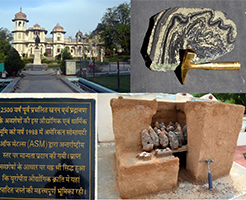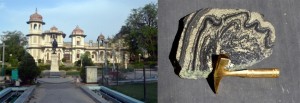BLOG
Wah! Udaipur Wah!! Its founding & a concise Photo-fact-file since 1553 CE’

Dr Pushpendra Singh Ranawat, a retired Professor of Geology from the MohanlalSukhadia University, Udaipur, has compiled his writings and research in this publication titled ‘Wah! Udaipur Wah!!’.The 120-page book is brimming with amazing facts drawn from the academic world of geology, geography, history, spirituality, religion and folklore…here is a glimpse of Prof Ranawat’s thoughts and ideas on Udaipur’s reinvention as a Smart Heritage City.
Prof Ranawat writes, “Udaipur area has rich thousands-of-years old history and heritage to its credit, but unfortunately just the post-medieval aspects of it are mostly talked of. The well-protected and human settlement-friendly Girwa valley has been inhabited and developing for past 4000+ years while its contemporary MohenjoDaro and Harappa civilizations went extinct long back. This area has been metal and mineral producing region that had attracted the attention of Samraat Ashok Maurya (304-232 BCE) and Indo-Greek Seleucid rulers (Apollodotus 180-160 BCE; Menander 165-133 BCE). Therefore the pre-historic and proto-historic aspects of this land need to be understood and promoted.”
“The present Smart City Conclave (held on May 21, 2016) is indeed a welcome step to interact with implementing agencies & the public regarding the Smart City aspects for Udaipur. But besides the fundamental aspects as outlined in the objective of the Conclave, some Protohistoric Aspects of Udaipur too need to be taken into consideration and promoting them for making Udaipur a uniquely Smart city.”
“Some of the more important Specific Aspects that need our attention and public inputs are:
A representative museum of the city that showcases the uniqueness of Udaipur can be recreated at the favorable location of SaraswatiBhawan in GulabBaag, with vehicular entry from the east gate and vehicle parking at the old Sambhar enclosure east of SaraswatiBhawan. The display items lying at the City Palace State Government Museum (store rooms), which is hardly visited by public & the tourist, should be reintroduced at SaraswatiBhawan (Ajaibghar of yore) along with replicas of important items of Ayad Museum and other archaeological sites of Banas Valley Civilization.”
“The georesources of this area have been the reason for Mewar’s strength in the past, which is still continuing; therefore a ‘Natural History’ Section in the museum should be developed with the help of Udaipur-located State Government Directorate of Mines & Geology; Hindustan Zinc Ltd.; and Rajasthan State Mines & Minerals Ltd along with other minerals industry organizations. A suitable fee would readily be paid by visitors to such a museum, which will generate resources for its upkeep and development (ultimately aiming a status of an international museum like the Smithsonian Museum). Larger samples of local rocks and minerals can also be displayed outside the SaraswatiBhawan in the garden.”
Prof Ranawat focuses his attention on Ayad. He recommends, “The 4000 year-old Heritage Walk of Ayad locality needs to be developed. It will highlight the prehistoric, proto-historic, and historic journey of Ayad area with appropriate signages and a Heritage Walk of Dhoolkot Excavations, along with Ayad Museum and the Jain Temple Complex. There is also the GangodbhavKund, Shiv Temple and Mahasatiya. There is potential to open a midway-type refreshment-and-rest room facility. This site could ultimately be developed as a UNESCO Heritage Site.”
“ZawarGeoheritage Site is located about 40 km south of Udaipur and is well connected by road. This site visit should start with the elegant and historic RamanathKund (commissioned on March 11, 1497) with visit to ancient smelting retort heaps, damaged Jain Temples for which rock inscription signages will be needed.”
“The plaque of American Society of Metals-ASM International recognized Zawar as the world’s oldest zinc smelting center (1988) and carbon dating by British Museum London confirms of its 2500+ year-old mining and smelting history (1983). An “Interpretation Center” building (Museum) is to be developed here as at Ayad and an ancient underground mine is to be developed for visit by tourists. The site has ancient mining, metallurgic, archeologic, historic, rural elements. This site is ultimately to be developed as a UNESCO Geopark.”

